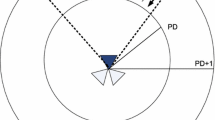Abstract
A probabilistic approach to the mobile station location problem is analyzed, and an algorithm that implements such an approach is presented. Information about the mobile station location is collected in the form of two-dimensional probability density functions provided from various sources. Combining the probability density functions into a joined probability density function is addressed. To provide computational efficiency, a method to limit the space of a possible location of the mobile station to a rectangular region of the minimal size is presented. Discretization of space is performed next, reducing the probability density functions to matrices of probabilities. The algorithm for combining the probability density functions is adjusted for an application with the matrices of probabilities. To reduce the computational burden further, probability density functions of the exclusion type, taking only two values, zero and nonzero, are introduced, providing savings in storage space and computational time. Information about the timing advance parameter value and the received signal level are interpreted by probability density functions of the exclusion type. Application of the algorithm is illustrated by two sets of measurements performed in an urban and a suburban region.


Similar content being viewed by others
References
Drane C, Macnaughtan M, Scott G (1998) Positioning GSM telephones. IEEE Commun Mag 36(4):46–54, 59
FCC (2001) Fact Sheet—FCC Wireless 911 Requirements. FCC, Washington, D.C.
Sun G, Chen J, Guo W, Liu KJR (2005) Signal processing techniques in network-aided positioning—a survey of state-of-the-art positioning designs. IEEE Signal Process Mag 22(4):12–23
Reed JH, Krizman KJ, Woerner BD, Rappaport TS (1998) An overview of the challenges and progress in meeting the E 911 requirement for location service. IEEE Commun Mag 36(4):30–37, 59
Simić M, Pejović P (2009) A comparison of three methods to determine mobile station location in cellular communication systems. Eur Trans Telecommun. doi:10.1002/ett.1333
Borkowski JM (2008) On applicable cellular positioning for UMTS. Doctor of technology dissertation, institute of communication engineering, Tampere Technology University
BIPM, IEC, IFCC, ISO, IUPAC, IUPAP, and OIML (1993) Guide to the expression of uncertainty in measurement. International Organization for Standardization, Geneva
Küpper A (2005) Location-based services: fundamentals and operation. Wiley, Chichester
Gwon Y, Jain R, Kawahara T (2004) Robust indoor location estimation of stationary and mobile users. In: Proceedings of twenty–third annual joint conference of the IEEE computer and communications societies. (Infocom 2004), vol 2. IEEE, Hong Kong, pp 1032–1043
Manolakis DE (1996) Efficient solution and performance analysis of 3-D position estimation by trilateration. IEEE Trans Aerosp Electron Syst 32(4):1239–1248
Nishida Y, Kitamura K, Hori T, Nishitani A, Kanade T, Mizoguchi H (2004) Quick realization of function for detecting human activity events by ultrasonic 3D tag and stereo vision. In: Proceedings of the second IEEE annual conference on pervasive computing and communications, (PERCOM’04), pp 43–54
Savvides A, Han CC, Strivastava MB (2001) Dynamic fine-grained localization in ad-hoc networks of sensors. In: Proceedings of 7th international conference on mobile computing and networking, pp 166–179
Sugano M, Kawazoe T, Ohta Y, Murata M (2006) Indoor localization system using RSSI measurement of wireless sensor network based on ZigBee standard. In: Proceedings of IASTED international conference on wireless sensor networks, (WSN 2006), Banff
Rice A, Harle R (2005) Evaluating lateration-based positioning algorithms for fine-grained tracking. In: Proceedings of the 2005 joint workshop on foundations of mobile computing, DIALM-POMC ’05
Wendlandt K, Ouhmich A, Angermann M, Robertson P (2002) Implementation of soft location on mobile devices. In: International symposium on indoor localisation and position finding, DGON
Fox D, Hightower J, Kauz H, Liao L, Patterson D (2003) Bayesian techniques for location estimation. In: Proceedings UBIComp Workshop, pp 16–18
Roos T, Myllymäki P, Tirri H (2002) A statistical modeling approach to location estimation. IEEE Trans Mobile Comput 1(1):59–69
Kontkanen P, Myllymäki P, Roos T, Tirri H, Valtonen K, Wettig H (2004) Topics in probabilistic location estimation in wireless networks. In: 15th IEEE International symposium on personal, indoor and mobile radio communications, (PIMRC 2004), vol 2, pp 1052–1056, 5–8 September 2004
Chu KMK, Leung KRPH, Ng JKY, Li CH (2004) Locating mobile stations with statistical directional propagation model. In: Proceedings of 18th international conference on advanced information networking and applications, (AINA 2004), Fukuoka, pp 230–235, 29–31 March 2004
Chu KMK, Ng JKY, Leung KRPH (2006) A new approach for locating mobile stations under the statistical directional propagation model. In: Proceedings of the 20th international conference on advanced information networking and applications, (AINA 2006), vol 1, pp 932–940
Papoulis A (1991) Probability, random variables and stochastic processes. McGraw Hill, New York
3GPP (2005) 3GPP TS 05.08, release 1999 (v8.23.0), Radio subsystem link control. http://www.3gpp.org/ftp/Specs/archive/05 series/05.08
Buchanan W, Munoz J, Manson R, Raja K (2004) Analysis and migration of location-finding methods for GSM and 3G networks. In: Proceedings of 5th IEE international conference on 3G mobile communication technologies, pp 352–358
Seidel SY, Rappaport TS, Jain S, Lord ML, Singh R (1991) Path loss, scattering, and multipath delay statistics in four European cities for digital cellular and microcellular radiotelephone. IEEE Trans Veh Technol 40(4):721–730
Rappaport TS (2001) Wireless communications principles and practice, 2nd edn. Prentice Hall, Englewood Cliffs
Sklar B (1997) Rayleigh fading channels in mobile digital communication systems, part I: characterization. IEEE Commun Mag 35(7):90–100
Acknowledgements
The authors would like to thank Professor Miroslav L. Dukić of the School of Electrical Engineering, University of Belgrade, for suggesting the research topic and for his valuable comments on the manuscript.
Author information
Authors and Affiliations
Corresponding author
Rights and permissions
About this article
Cite this article
Simić, M.I., Pejović, P.V. A probabilistic approach to determine mobile station location with application in cellular networks. Ann. Telecommun. 64, 639 (2009). https://doi.org/10.1007/s12243-009-0113-2
Received:
Accepted:
Published:
DOI: https://doi.org/10.1007/s12243-009-0113-2




